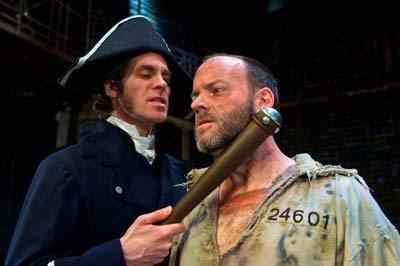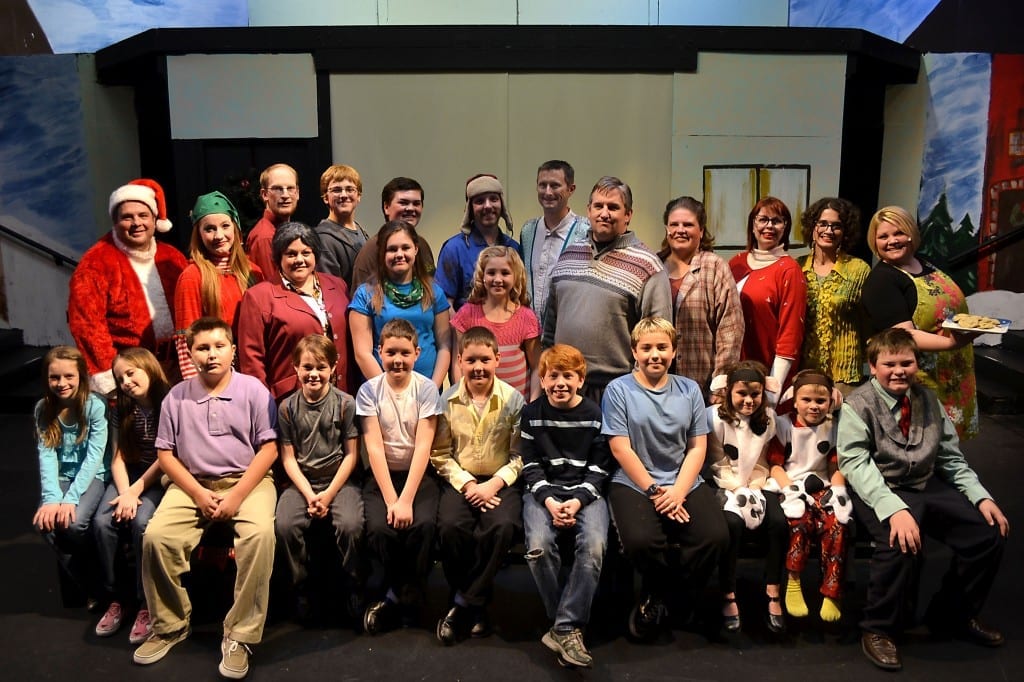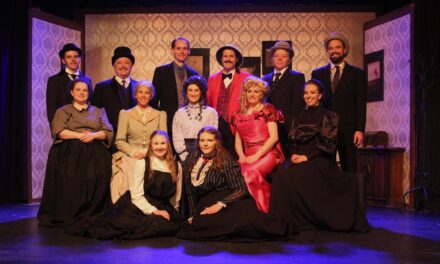WEST JORDAN — “When a man is tired of London, he’s tired of life.” Richard Hannay is tired of London, and therefore, as Samuel Johnson once concluded, tired of life. He is stuck in the doldrums, wandering wistfully through his aimless existence, until a fateful night at the theater hurls his life into a whirlwind of assassinated femme fatales, clandestine plots, framed murder, leaps from trains, trudging through the frigid Scottish countryside, and, of course, a bit of romance.
The 39 Steps is a humorous pastiche of Alfred Hitchcock‘s 1935 film of the same name, tossing in a few more references to the master director’s work, including mentions (and sometimes direct parody) of Strangers on a Train, Rear Window, Psycho, North by Northwest, and Vertigo. Playwright Patrick Barlow adapted the film into a minimalist farce, with basic set directions and only four actors playing every role, of which there are over a dozen.
The set, designed by Vic and Michelle Groves, along with Travis, Brandon, and Robyn Green, was not only built to utilize the space of the former library now known as the Sugar Factory Playhouse, but it was also ingenious, creative, entertaining, and immersive. It was definitely one of my favorite aspects of the show, from the door on wheels that was used to great comedic effect, particularly in a scene wherein Travis Green (Clown 1) plays the theatrically graceful Mrs. Jordan, to the blocks and bars used in an hilarious train bit, to a ladder that was, in one instance, borne across Travis Green’s shoulders to signify an airplane.
Perhaps the strongest element of the production was the physical comedy. All four actors are gifted in the area of slapstick, and, with the addition of deftly-executed sight gags (breaking the fourth wall with prop malfunctions; the villain zooming around the stage in a rolling chair; a street sign hoisted by a frustrated Scotsman which also happened to be covered in crows as a reference to The Birds), the play flew from one silly situation to the next. The actors crawled over one another, got tangled in heaps, maneuvered their way around the stage and props with vaudevillian expertise, and bounded from scene to scene with rhapsodical energy and pacing.
As Richard Hannay, Anthony Lovato was in top form as the dashingly handsome comedic lead, reminiscent of Cary Grant (which is fitting, really, as Mr. Grant was one of Hitchcock’s favorites), complete with the hammy facial expressions and athletic vigor, which lent themselves to the style of the play adroitly. While all of the other actors rotated from one character to the next, Lovato’s solid handling of the single role he played carried the production with fluidity, as a hub to a wheel with many spokes. One scene wherein he is mistaken for a political candidate and delivers a rousing speech—underscored by the British anthem “Jerusalem”—showed his sweeping range. His accent was also the most expertly accomplished in the show, which I greatly appreciated.
Indeed, my one complaint about the production would be that it could have used a dialect coach. Often, the wavering cadences of British and Scottish (which would sometimes meld into Swedish, Irish, and West Country or “Pirate”), detracted from the comic talents of the actors, which were exceptional. I found myself wishing that director Michelle Groves had simply instructed actors who couldn’t handle an accent to drop it entirely. That being said, it is a small problem, and one that should not discourage theater and Hitchcock enthusiasts from seeing the play. Michelle Groves directed every other element of rapid-fire lampooning with the ability of someone who clearly has experience in the arena of comedy, honing in her players by implementing their unique and varied skills while maintaining the tight-as-a-drum feel of farce. It was one of the best comedic directions I’ve seen in a while.
As the two Clowns, Travis Green and Bob Bedore dazzled in their dizzying charge: to run around like maniacs changing costumes, wigs, hats, and props as their characters shifted at full throttle, sometimes compelling them to play several in a scene. This was put to good effect in two instances in particular: a scene on a train in which they played 3-4 characters each (I lost track, I was laughing too hard), and a scene wherein they played a Scottish couple who owned an inn and a pair of Bronx detectives, continuing the dialogue while they stepped in and out of coats, hats, false mustaches, and nightgowns. Along with their apt treatment of this challenge, they were both downright funny, Travis Green with his rubber-like face that molded into many masks combined with varied vocal talents, and Bedore with his adeptness at absurdity and improvisation.
Britany Fullmer was a delightful leading lady, playing the three women with whom Richard finds himself romantically entangled with charm and jocularity. She added a refreshing lightness to the play, floating around her three male co-stars with effervescent ease. My favorite scenes with her included a knife-in-the-back “stiff” scene (stiff being the operative word), where she transformed her body into a solid plank, an impressive feat for anyone to accomplish, and another in which she complains about the miserable circumstances that she and Richard find themselves in while crawling around and around and around a stile with her co-star, a handcuff around her wrist.
A major aspect of the storytelling is the costuming, and I must give a nod to Patti Secrist, who designed not only the myriad costumes that the Clowns had to get in and out of easily and quickly, but clothing that also allowed the actors to do all the leaping, running, and stooping that the script required. My one wish was that she had put Fullmer in character shoes, as I sometimes feared for the actress’s safety in the heels she was wearing, but on the whole, it was very well done. Another technical element that stood out was the scoring, which was largely borrowed from Hitchcock’s films (namely Psycho), and served as an expressive and colorful backdrop, along with the sound cues, mixed by Lovato.
Ultimately, my thought is that this show doesn’t have a nearly long enough run for how excellent it is, and I certainly hope it gets the audience numbers it deserves. I plan on going back for a second viewing. And a third.





